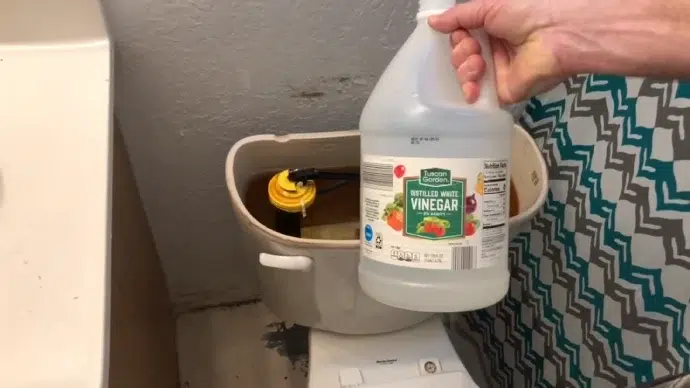Last Updated on April 11, 2023
Vinegar is the solution for RV owners looking for an efficient, affordable way to keep their bathrooms sparkling and fragrant. This common household item has impressive cleaning properties that help you maintain a fresh environment in your recreational vehicle without breaking the bank.
This blog post will give you all the information you need to choose your RV toilet best. Here you will learn about vinegar, its advantages and disadvantages, how to use it safely, and more natural options with some safety tips. Continue reading to learn more.
RV Toilets: Can You Put Vinegar in Them?
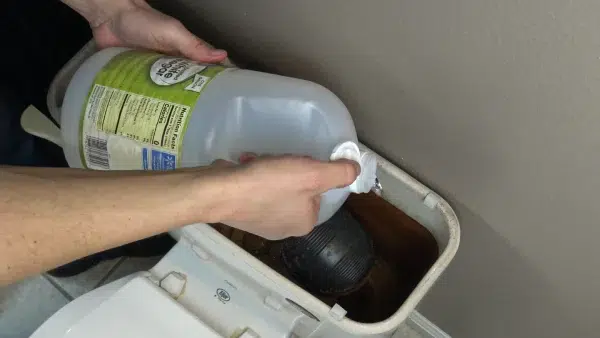
Don’t let a smelly RV toilet ruin your road trip; try vinegar cleaning. Believe it or not, white distilled vinegar can be an effective and natural alternative when sanitizing these tricky toilets. Plus, you won’t have to worry about harsh chemical residues on surfaces with which the whole family will come in contact.
Vinegar is a natural and eco-friendly cleaner that can effectively remove stains and odors from your RV toilet without damaging the plumbing system. It is also much cheaper than chemical cleaners, making it an ideal choice for those on a budget.
Vinegar as an Alternative to Chemical Cleaners
Vinegar is a popular alternative to chemical cleaners for RV toilets, and for a good reason. Not only is it an effective cleaning agent, but it is also eco-friendly and inexpensive. Vinegar contains acetic acid, which can dissolve mineral deposits and bacteria that cause unpleasant odors.
However, it’s important to note that vinegar should not be used as a replacement for regular dumping and cleaning of the RV toilet tank. It’s merely an additional tool to keep the toilet clean and fresh between cleanings.
Benefits and Drawbacks of Using Vinegar in an RV Toilet
Using vinegar in an RV toilet has its benefits and drawbacks. On the one hand, vinegar is a natural alternative to chemical cleaners that can be harsh on the environment and potentially damage your RV’s plumbing system. On the other hand, vinegar may not be as effective at removing tough stains and odors as chemical cleaners.
One of the main benefits of using vinegar for RV toilets is that it is environmentally friendly. Unlike chemical cleaners, vinegar does not contain harmful toxins or chemicals that can harm aquatic life when disposed of improperly.
Additionally, vinegar is biodegradable, which means it breaks down naturally over time and does not contribute to pollution.
Another benefit is that vinegar can help prevent mineral buildup in the plumbing system. Hard water minerals like calcium and magnesium can accumulate over time and cause clogs or damage to pipes. Vinegar’s acidic properties can dissolve these minerals and prevent buildup from occurring.
However, there are also some drawbacks to using vinegar in an RV toilet. One major drawback is that it does not effectively remove tough stains or odors as chemical cleaners. While vinegar can help remove mold stains and freshen up the toilet bowl, it may not be able to tackle more stubborn grime or deep-set odors.
In addition, using too much vinegar or leaving it in the bowl for too long can damage the rubber seals in your RV’s plumbing system. This could lead to leaks or other issues down the line.
Steps to Clean Your RV Toilet with Vinegar
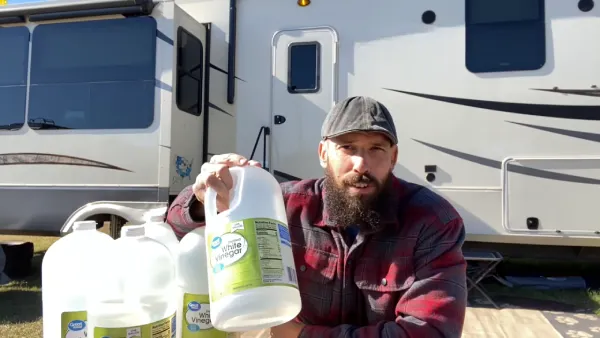
Vinegar is also affordable and readily available as a natural and eco-friendly solution. You can have your RV toilet smelling and looking brand new in just a few steps. From preparing the bowl to flushing away any remaining residue, we’ll guide you through cleaning an RV toilet with vinegar.
Step 1: Preparing the Toilet Bowl
To effectively clean your RV toilet with vinegar, it is essential to prepare the toilet bowl properly. This involves removing any debris or buildup that may be present before applying the vinegar solution.
First, put on a pair of rubber gloves to protect your hands from any bacteria or germs that may be present in the toilet bowl. Next, use a toilet brush to scrub the inside of the bowl and remove any visible debris or stains.
Once you have removed as much debris as possible, it is time to apply the vinegar solution. It is recommended to use a mixture of equal parts white vinegar and water for cleaning an RV toilet. This solution effectively breaks down mineral deposits and other buildup that can accumulate in the toilet bowl.
Step 2: Pouring the Vinegar Solution into the Bowl
After preparing the vinegar solution, as discussed in the previous section, the next step is pouring it into the bowl.
To do this, start by opening the RV toilet lid and seat. Then, take the container with the vinegar solution and slowly pour it into the bowl. Make sure to pour enough solution to cover all areas of the bowl.
Using a funnel or measuring cup with a spout is recommended to make pouring more accessible and more precise. This will help prevent spillage and ensure that you are using the correct amount of solution.
After pouring the vinegar solution, let it sit for 10-15 minutes. This will allow enough time for the vinegar to break down any stains or buildup in your RV toilet bowl.
Step 3: Scrubbing the Bowl with a Brush
When cleaning an RV toilet with vinegar, scrubbing the bowl with a brush is essential to remove all stains and dirt. A good quality toilet brush will make the job easier and more effective.
Firstly, ensuring that the vinegar solution has been poured into the bowl and left to sit for at least 10-15 minutes is essential. This will allow the vinegar to break down any buildup or mineral deposits in the bowl.
Next, scrub the inside of the bowl thoroughly using a toilet brush with stiff bristles. Pay extra attention to areas where stains or buildup are present. Be sure to reach under the rim of the bowl as well.
It may be helpful to use a circular motion while scrubbing, starting from the top of the bowl and working your way down toward the waterline. This will help ensure that all bowl areas are covered and cleaned correctly.
Step 4: Flushing and Repeating The Process If Required
After scrubbing the bowl with a brush, it’s time to flush and repeat the process if required. Flushing the toilet will remove any remaining vinegar solution and debris from the bowl. It is essential to ensure that all the vinegar solutions have been flushed out of the toilet before using it again.
If you notice that there are still stains or build-ups in your RV toilet after the first cleaning, don’t worry! Simply repeat the process until your toilet bowl is clean and fresh.
It’s important to note that while vinegar is an effective cleaner for RV toilets, it may not be able to remove all types of stains or build-up. Sometimes, you may need to use a specialized cleaner or seek professional help.
RV Toilet Cleaners: Alternatives to Chemicals
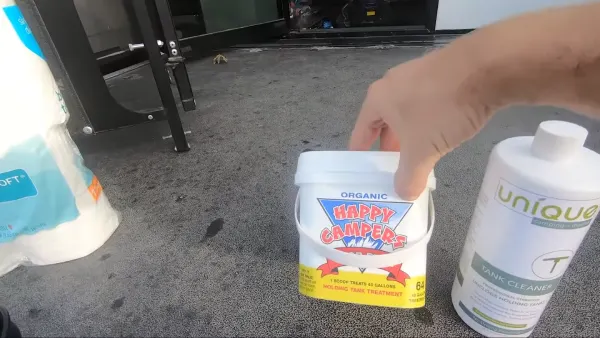
Many people prefer natural alternatives to chemical cleaners when cleaning an RV toilet. While vinegar is a popular choice, other options are also available.
- Baking Soda: One alternative to vinegar is baking soda. Simply sprinkle baking soda into the toilet bowl and scrub with a brush. This will help remove stains and odors without using harsh chemicals.
- Lemon Juice: Another option is lemon juice. It has natural antibacterial properties and can be used to clean the toilet bowl and freshen the air in the bathroom. Squeeze some lemon juice into the bowl and let it sit for a few minutes before scrubbing it with a brush.
- Tea Tree Oil: You can also use tea tree oil for cleaning by adding it to vinegar or water. It has antifungal, antibacterial, and antiviral properties, making it effective against germs and bacteria.
While these natural alternatives may be gentler on your RV’s plumbing system than chemical cleaners, using them safely is essential. Always dilute vinegar or tea tree oil with water before using them in your toilet, as they can be too strong in their pure form.
RV Toilet Safety: Precautions for Using Vinegar and Natural Alternatives
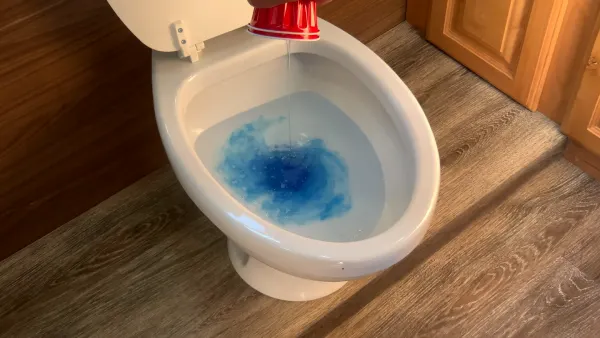
Due to health and environmental concerns, many RV owners prefer to use natural alternatives such as vinegar instead of chemical cleaners. However, there are some precautions to remember when using vinegar or other natural alternatives in an RV toilet.
#1. Vinegar May Not Be as Effective as Chemical Cleaners
While vinegar is an excellent natural cleaner and deodorizer, it is less effective than chemical cleaners like Pine Sol or Lysol when breaking down waste and preventing clogs.
Therefore, using vinegar regularly is essential as part of your cleaning routine. Still, if you encounter a stubborn clog or buildup in your RV toilet, you may need to use a chemical cleaner or seek professional assistance.
#2. Avoid Mixing Vinegar with Other Cleaning Products
Mixing vinegar with other cleaning products, such as bleach or ammonia, can create harmful fumes that can be dangerous if inhaled. Always read the labels of any cleaning products you plan to use and follow the instructions carefully. To avoid accidents, it’s best to use vinegar on its own.
#3. Dilute Vinegar with Water Before Use
Too much vinegar in your RV toilet can damage the seals and gaskets over time. This is because vinegar is acidic and can break down rubber materials. To prevent this, dilute the vinegar with water before using it in your RV toilet. A good rule of thumb is to mix equal vinegar and water.
#4. Be Cautious with Composting Toilets
If you have a composting toilet in your RV, vinegar or other cleaning products may interfere with the natural composting process.
Therefore, it’s best to check with the manufacturer of your composting toilet before using any cleaning products. Some manufacturers recommend using only water or specific natural products to clean their composting toilets.
Can you leave baking soda and vinegar in an RV toilet overnight?
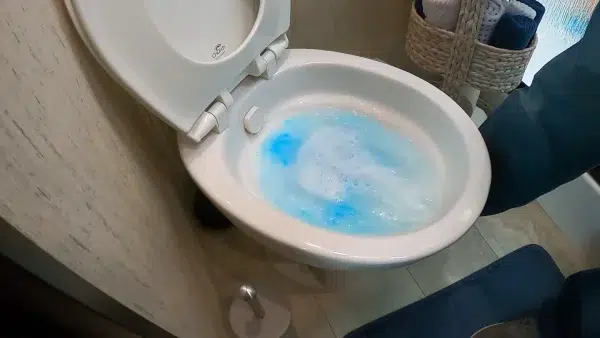
You can leave baking soda and vinegar in your RV toilet overnight. Baking soda is a natural deodorizer and mild cleaner, and white vinegar is a great cleaning agent and has natural disinfectant properties.
Mixing the two together creates a powerful cleaning solution that will help keep your RV toilet clean and odor-free. The mixture should be left in the bowl for at least an hour before flushing it away.
For best results, leave it overnight to maximize its effectiveness. This cleaning method helps keep your RV toilet clean and uses natural products that are safe for the environment.
What happens when you pour white vinegar into your RV toilet tank?
When white vinegar is poured into an RV toilet tank, it helps to break down any stains and deposits caused by hard water. It can help keep the toilet bowl from becoming stained and discolored over time and prevent odors and clogs.
Vinegar acts as a natural disinfectant and has antibacterial properties, which makes it ideal for cleaning the inside of the tank. For best results, pour 1 cup of white vinegar into the RV toilet tank, then let it sit overnight.
In the morning, flush the tank several times with fresh water to remove any remaining smell or residue from the vinegar. Regularly pouring white vinegar into your RV toilet tank will help keep it clean and smelling fresh.
Get a Fresh, Natural Clean for Your RV Toilet: Try Vinegar
As we’ve discussed, vinegar can be a safe and effective alternative to chemical cleaners in your RV toilet. It’s eco-friendly, cost-effective, and easy to use. However, it’s essential to be aware of the potential drawbacks, such as its strong smell and potential damage to specific toilet components.
You can safely use vinegar to keep your RV bathroom clean on the road by taking the necessary precautions, like diluting the vinegar and wearing gloves. So, try this natural solution next time you’re camping or traveling in your RV.

